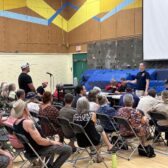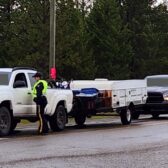One-stop drop-in-centre lauded by Street Culture Working Group as part of street solution
A one-stop drop-in centre servicing the city’s growing street culture could be established by the city’s street culture working group.
The centre would house multiple services and supports, the executive director of Nelson Community Service Centre, Rona Park, told council recently.
She gave city council a brief overview of the best practices formulated by the Downtown Nelson Street Culture Collaborative Working Group — an offshoot of the Downtown Nelson Street Culture Collaborative — and put in a request for council’s help in the future on several projects, including the centre.
“Drop-in centres have long been seen as an effective and efficient way for ensuring that those who are homeless or otherwise disconnected from services can get their needs met in the least intrusive, least intimidating, least complex, and most welcoming manner,” she said.
“They can be quite helpful, but they can also be quite expensive. We would have to see how we might structure that, and what we already have in place that might work.”
Park said drop-in centres typically provide food and meals, housing support services, health care services, mental health and addictions services, counselors and social workers, peer support and mentoring, and opportunities for connection, socialization and volunteering.
Centres are often staffed by both professionals and volunteers. More minimal services could be available on weekends yet still be open for socialization and space to “come in out of the cold.”
In October 2015 the Downtown Nelson Street Culture Collaborative Working Group was created by the Street Culture Collaborative Group to further identify the needs of the street culture population and “capture their voices.”
The group looked at other communities’ approaches to the situation and tried to develop recommendations for a more coordinated, caring community response “to the needs of this population,” said Park.
“The goal of this initiative is to improve the ways in which Nelson’s street culture population access services and stabilization supports, thereby reducing risks to individual and public safety as well as any negative impacts on local businesses often attributed to this population,” Park said.
She estimated that there were upwards of 30 individuals who fell into the “population” classification that the panhandling bylaw was directed toward.
Several promising best practices were developed, she added, and it included:
- Implementation of a multi-disciplinary crisis response team (24/7) dedicated to being first responders to high-risk emergency calls regarding this population;
- Implement a street outreach team that would include the use of peers (people with lived experience of street life) and potentially a beat officer;
- Create formal partnerships and protocols amongst all community and health service providers, police, downtown businesses, the library, recreation, literacy, and employment services that would ensure a consistent, immediate, and appropriate response to those in this population attempting to seek services and supports;
- Provide mental health first aid training to all service providers, downtown business owners, chamber of commerce, NAEDP, city personnel such as by-law officers, parks workers, library staff, etc., and police, and that this also be available to the general public;
- Implement a “one-stop” drop-in centre which houses multiple services and supports;
- Explore possibility for providing a temporary work options program;
- Continue to build on and support all the programs and services that are working well, particularly the pursuit of more affordable and supportive housing options and regional addictions treatment beds;
- Track the outcomes of a more comprehensive coordinated approach to supporting this population.
“I really think implementing some of these initiatives can begin to tackle some of those fallout issues where people’s needs aren’t being met and they resort to other measures to try and do that,” Park said.
The working group has acknowledged there is a good array of services and supports in Nelson already, Park told council. But to meet some of the proposed objectives, it will require clarifying and strengthening existing working relationships to ensure no duplication of services, no deferral of responsibilities onto other services, and to clarify purpose and roles.
“It may also require that existing service providers be willing to restructure their current service design to better meet the needs of this specific population,” Park said.
With some grants in hand, said Park, someone could be hired who could bring all of the strings and groups together in the city to pull off the best practices.
Point-in-time homelessness count
A count of those who are homeless in Nelson will be undertaken by the Nelson Committee on Homelessness (NCOH) on April 13, and city council has been asked to help.
Speaking on behalf of the NCOH to city council recently, Ann Harvey said the Point-in-Time Homeless Count uses a method that counts individuals who are staying in shelters or “sleeping rough” (on the street, in parks, etc.).
It is a survey conducted over a 24-hour period to gather information about the extent and nature of homelessness in the city.
“A successful PiT Count will allow our community to better identify the characteristics and needs of the local population,” Harvey told council.
The count will allow local groups to plan for and develop programs to address homelessness, measure progress towards ending homelessness, increase public awareness about homelessness and test the efficacy of programs and interventions aimed at ending homelessness.
NCOH asked the city to cover its liability insurance to conduct the count.
“We estimate a maximum of 120 volunteers, all of whom will be required to take mandatory training,” said Harvey.
Nelson’s PiT Count hopes to include:
- A count of those in emergency shelters (Stepping Stones and the Aimee Beaulieu Transition House, done by staff);
- A count of those living in transitional housing (non-permanent and often programed supportive housing, likely done by staff);
- A count of those sheltered in “public systems” from Nelson who have either no-fixed address or no permanent housing to return to (e.g. hospitals, detention centres, treatment or detox centres, safe homes, youth in care, etc. by way of an administrative report);
- A count of those people who have no shelter at all over specified daylight hours in various public and service locations — those living in vehicles, parks, tenting etc., and;
- The hidden homeless — people, often youth — who are couch surfing or staying with friends, family or acquaintances because they have no safe or permanent place to stay.
The count is part of an initiative launched by the Government of Canada’s Homelessness Partnership Strategy (HPS). From January to April 2016 communities across Canada will participate in a coordinated Point-in-Time Count.
The HPS Coordinated Count will build a national picture of homelessness by counting the number of people experiencing absolute homelessness and surveying them to understand their demographics and service needs.
For more information on the national PiT Counts:
- Point-in-Time Toolkit developed by the Canadian Observatory on Homelessness at http://www.homelesshub.ca/pitcounttoolkit
- The Guide to Point-in-Time Counts in Canada for technical information on the count at http://www.esdc.gc.ca/eng/communities/homelessness/pit_countguide.shtml



























